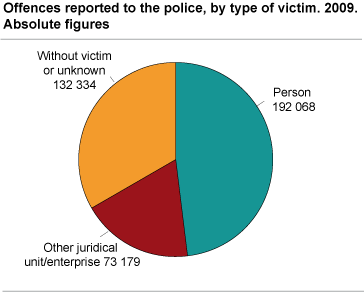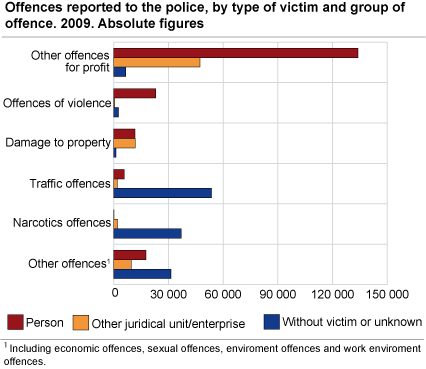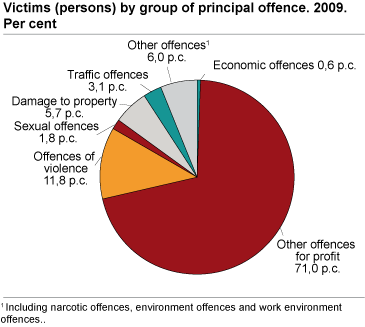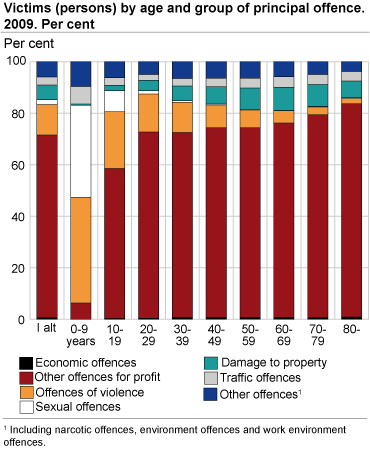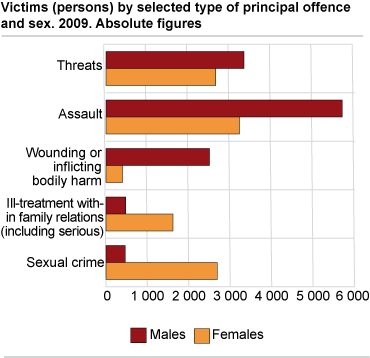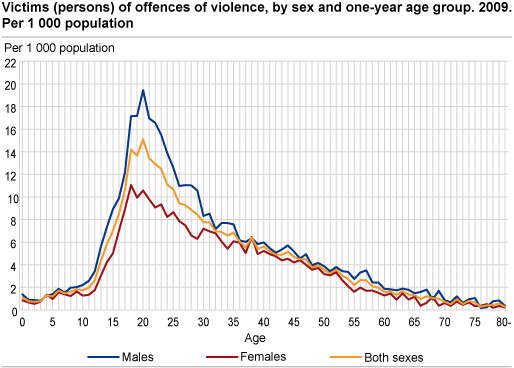Content
Published:
This is an archived release.
176 000 persons victims of offences
Offences reported to the police show that 3.3 per cent more persons were victims in 2009 than the previous year. More female, but fewer young victims of violence are registered in the most recent years. The number of offences against enterprises rose 12 per cent from 2008 to 2009.
Of the 398 000 offences reported to the police in 2009, nearly half (48 per cent) were registered with a person as victim, and 18 per cent were registered as committed against enterprises or other juridical units. A total of 73 200 offences was committed against an enterprise - the highest number among the now six years of statistics on victims of offences reported to the police. Many offences do not inflict a direct experience of victimisation, and 33 per cent of all offences filed by the police were without a registered victim. Narcotics and traffic offences constitute two thirds of these (see figure).
More offences for profit against person and enterprise
Theft and other offences for profit make up about two thirds of all offences reported to the police against both persons and enterprises, and in 2009, 134 000 offences for profit were committed against persons and 47 300 against enterprises. The number of offences for profit decreased from 2008 to 2009 (see offences reported to the police ), and the statistics on victims of offences show that enterprises as well as persons had an increase of more than 6 000 offences. Enterprises had, however, a larger percentage increase (15 per cent) than persons (5 per cent).
In 2009, 126 000 persons were registered as victims of offences for profit, and more than one out of five of these victims lives in Oslo. There are major regional variations in the number of victims of offences for profit from year to year, and the residents of Hordaland had the greatest increase from 8 900 in 2008 to 11 000 in 2009.
Different age groups are victims of different groups of offences
How many are exposed to, and what type of offence they are exposed to, varies by sex - but to an even larger extent by age (see also Survey of level of living, victims and crime ). Young adults have a far higher risk of being registered as victims of offences than the youngest and oldest in the population. A total of 3.6 per cent of Norwegian residents were registered as victims of offences in 2009, whilst the corresponding figure in the age group 20-29 years was 7 per cent.
Looking at the separate age groups and distribution by principal group of offence, we find some relatively clear patterns and inequalities: 77 per cent of victims in the age group 0-9 years have been exposed to sexual or violent offences. The corresponding proportion of victims in the other age groups decreases with age. For example, 30 per cent of victims in the age group 10-19 years have violent or sexual offences as the principle offence, whilst the corresponding proportion is 2 per cent among victims of offences aged 80 or older. An approximate opposite pattern can be found relative to other offences for profit, damage to property and economic and traffic offences (see figure).
More female, and fewer male victims of violence
In 2009, 22 300 persons were registered by the police as victims of violence and threats - about the same number as in 2008. During the last four years, a greater share of the female, and a smaller share of the male population was exposed for offences of violence. These changes apply especially for physical violence, and in 2009 there were 4 per cent more women and 2 per cent fewer men than the preceding year.
Still most violence against men
Overall, males make up a larger share of the victims exposed to violent offences than females, and in 2009 men made up 60 per cent of the victims of this group of offence. The share of males is particularly large for wounding or inflicting bodily harm (86 per cent males) and assault (64 per cent males), but not as considerable among the victims of threats (56 per cent males). Females are, however, strongly over represented among victims of ill-treatment in family relations (including serious ill-treatment) and among victims of sexual crimes, were the share of females are 77 and 85 per cent respectively (see figure).
Young people most exposed to violence, but less so the last three years
Based on reports to the police, the risk of being exposed to violent offences is clearly highest during the very first years after reaching the age of 18 (the age of majority): this is the case for both males and females, but in this age range the risk of violence is considerably higher for males compared to females. After this, the exposure to violent offences reduces with age (see figure).
However, in 2007 there were 11.8 victims of violence per 1 000 of the population between 13 and 22 years old, while the share was 10.5 per 1 000 population in 2009. That is equivalent to an 11 per cent decrease, and the reduction for this age group is larger for males (14 per cent) than for females (6 per cent). Few in the youngest age groups are being registered as victims of violence (see figure), but these have increased the most in the last six years in relative terms.
Statistics on victims of offences, reported to the policeThe statistics are based on information from the police criminal record system (BL/STRASAK/PAL) and include all parties that are victims in all offences registered by the police in 2009. The statistics were published for the first time in 2006, and now include the years 2004-2009. Because of the practice in registration of victims and offences in BL/STRASAK/PAL, Statistics Norway cannot identify absolutely every registered offence that victims are exposed to (see tables 1, 2, 11 and 14). The quality of the basic data seems, however, to have improved considering the level of filling in of victims, particular last year. For instance, the share of thefts without a registered victim was reduced from 2.3 per cent in 2004 to 1.5 per cent in 2009, and for wounding or inflicting bodily harm the corresponding share was reduced from 8.1 per cent to 5.3 per cent (see also table 1). The statistics on victims of offences reported to the police are developed, produced and published on behalf of the Ministry of Justice and the Police. More on sampling, definitions and sources of errors is available in About the statistics . See also Statistics Norway’s Survey of level of living, victimization and fear of crime and enterprises' victimisation on economic crime in Ellingsen and Sky 2005 (only in Norwegian). |
Tables:
- Table 1 Offences reported to the police, by type of victim, category of offence and group of offence. 2009. Absolute figures
- Table 2 Victims (persons), by number of offences, sex and age. 2009. Absolute figures and per cent
- Table 3 Victims (persons), by sex, age and place of residence (county). 2009. Absolute figures and per 1 000 population
- Table 4 Victims (persons), by category of offence, group of principal offence, sex and age. 2009. Absolute figures and per 1 000 population
- Table 5 Victims (persons), by category of offence, group of principal offence and one-year age group. 2009. Absolute figures
- Table 6 Victims (persons), by category of offence, group of principal offence and one-year age group. 2009. Per 1 000 population
- Table 7 Victims (persons), by category of offence, group of principal offence and place of residence (county). 2009. Absolute figures and per 1 000 population
- Table 8 Victims (persons), by sex, age and type of principal offence. 2009. Absolute figures
- Table 9 Victims (persons) of offences for profit, by sex and one-year age group. 2009. Absolute figures and per 1 000 population
- Table 10 Victims (persons) of offences for profit, by sex, age and place of residence (county). 2009. Absolute figures and per 1 000 population
- Table 11 Victims (persons) of offences for profit, by number of offences for profit, sex and age. 2009. Absolute figures and per cent
- Table 12 Victims (persons) of offences of violence, by sex and one-year age group. 2009. Absolute figures and per 1 000 population
- Table 13 Victims (persons) of offences of violence, by sex, age and place of residence (county). 2009. Absolute figures and per 1 000 population
- Table 14 Victims (persons) of offences of violence, by number of offences of violence, sex and age. 2009. Absolute figures and per cent
The statistics is now published as Offences and victims reported to the police.
Contact
-
Statistics Norway's Information Centre
E-mail: informasjon@ssb.no
tel.: (+47) 21 09 46 42

